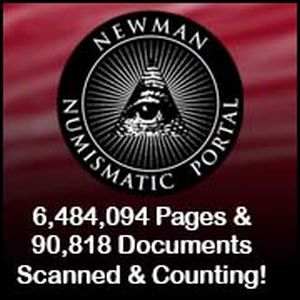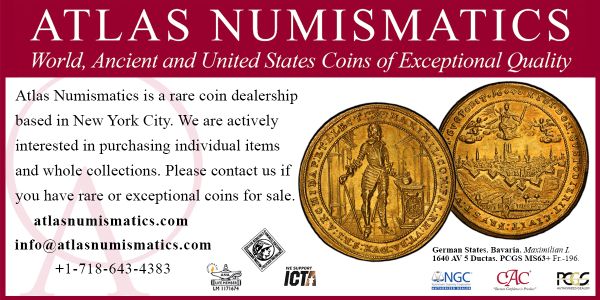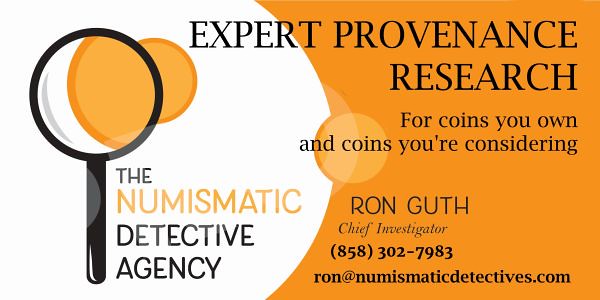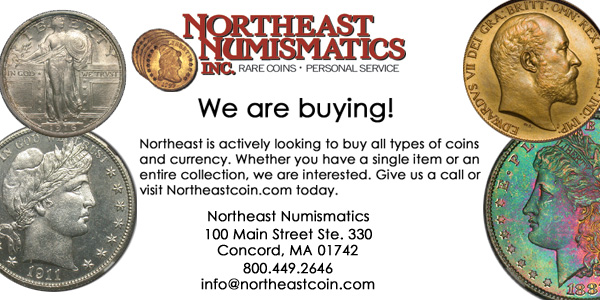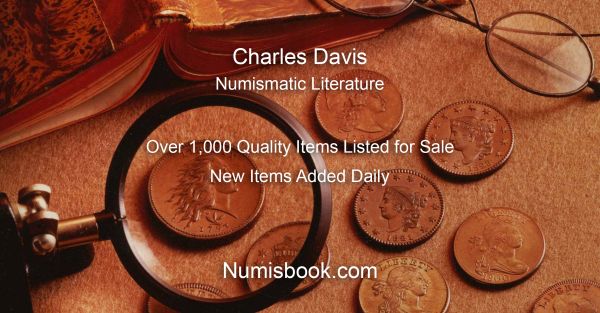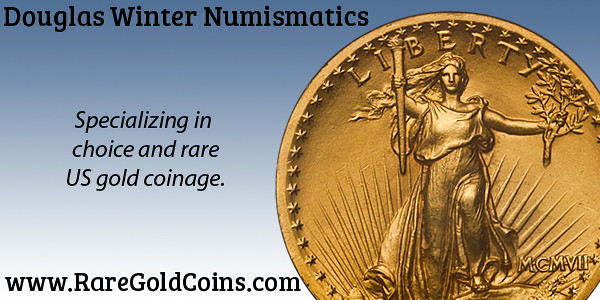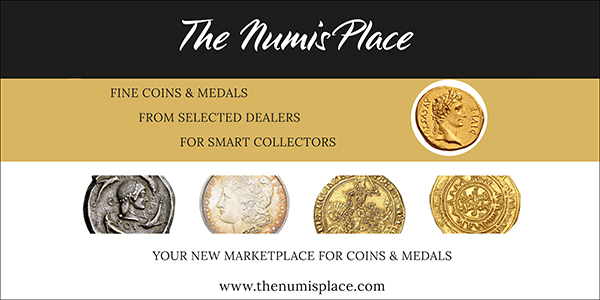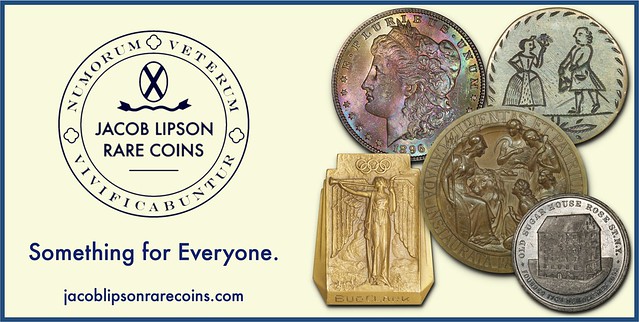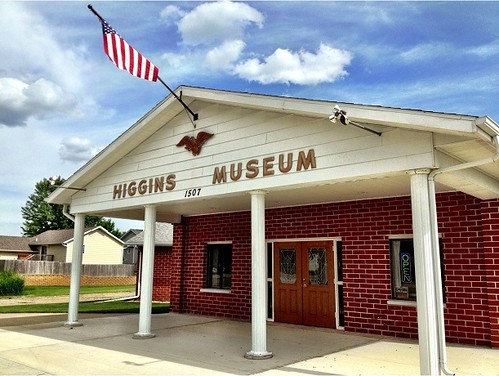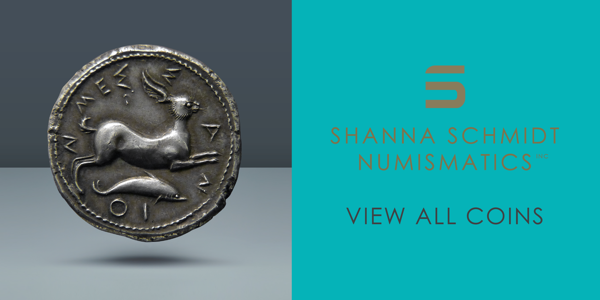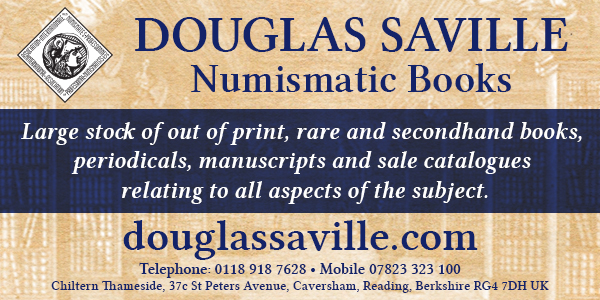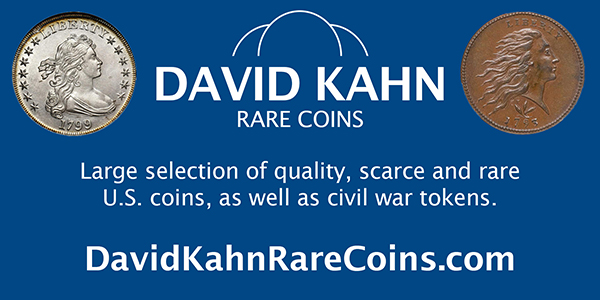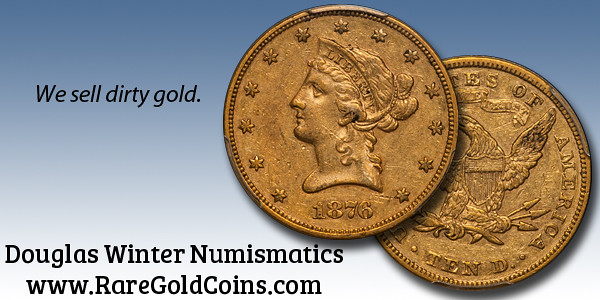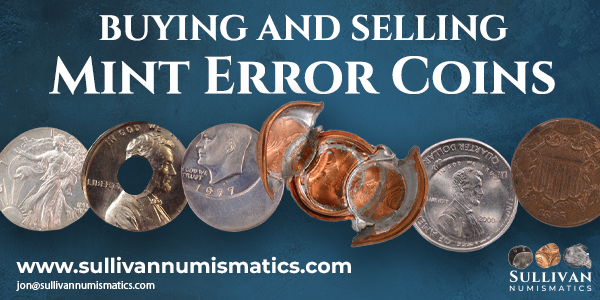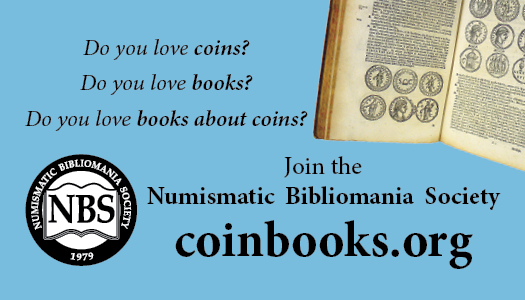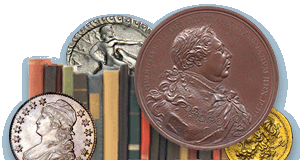
Visit our NBS Sponsors
About UsThe Numismatic Bibliomania Society is a non-profit association devoted to the study and enjoyment of numismatic literature. For more information please see our web site at coinbooks.org SubscriptionsThose wishing to become new E-Sylum subscribers can go to the following web page Subscribe MembershipThere is a membership application available on the web site Membership Application To join, print the application and return it with your check to the address printed on the application. Print/Digital membership is $40 to addresses in the U.S., and $60 elsewhere. A digital-only membership is available for $25. For those without web access, write to: Jeff Dickerson, Treasurer AsylumFor Asylum mailing address changes and other membership questions, contact Jeff at this email address: treasurer@coinbooks.org SubmissionsTo submit items for publication in The E-Sylum, write to the Editor at this address: whomren@gmail.com BUY THE BOOK BEFORE THE COINSale CalendarWatch here for updates! |
- WAYNE'S WORDS: THE E-SYLUM SEPTEMBER 7, 2025
- 2025 ANA NUMISMATIC LITERATURE EXHIBIT AWARDS
- NEW BOOK: THE NUMISMATIST'S GUIDE
- NEW BOOK: TRAVELS WITH THE NAXOS MASTERPIECE
- NEW TITLES IN WHITMAN'S RED BOOK SERIES
- NEW BOOK: CATALOG OF BELGIAN NUMISMATICS 2026
- CHARLES L. (CHUCK) MITTON (1943-2025)
- 2025 ANA CONVENTION NBS EVENTS
- MANUSCRIPTS IN NUMISMATIC LITERATURE & RESEARCH
- VIDEO: HISTORY OF THE RED BOOK
- SUBSCRIBE TO COIN WORLD AND THEIR BRETHREN
- MORE ON THE 16TH 1804 DOLLAR PROVENANCE
- NOTES FROM E-SYLUM READERS: SEPTEMBER 7, 2025
- HIGGINS MUSEUM RECEIVED MAJOR DONATION
- VOCABULARY TERM: ROCKER DIES
- RICHARD DAVID KENNEY (1918-1957)
- NUMISMAGRAM MEDAL SELECTIONS: SEPTEMBER 7, 2025
- WHITWELL HOARD OF BRITISH IRON AGE GOLD COINS
- VICTOR-EMMANUEL III MEDALS OFFERED
- SOVEREIGN RARITIES AUCTION XIX
- KUENKER AUCTION SALE 428
- GADOURY OCTOBER 4, 2025 ROMAN AUREI SALE
- 1715 FLEET: PHILLIP II ROYAL DOCUMENT SEAL
- THE LEWES POUND SHUTS DOWN
- MORE ON THE NEW SRI LANKA 2000 RUPEES NOTE
- ABOUT THIS ISSUE: SEPTEMBER 7, 2025
Content presented in The E-Sylum is not necessarily researched or independently fact-checked, and views expressed do not necessarily represent those of the Numismatic Bibliomania Society.
WAYNE'S WORDS: THE E-SYLUM SEPTEMBER 7, 2025
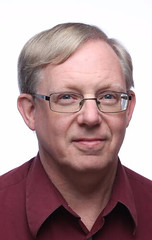 New subscribers this week include:
Hal "Spike" Greinman, courtesy Bill Rosenblum; and
Michael Powers, courtesy Peter Jones;
Welcome aboard! We now have 7,003 subscribers.
New subscribers this week include:
Hal "Spike" Greinman, courtesy Bill Rosenblum; and
Michael Powers, courtesy Peter Jones;
Welcome aboard! We now have 7,003 subscribers.
Thank you for reading The E-Sylum. If you enjoy it, please send me the email addresses of friends you think may enjoy it as well and I'll send them a subscription. Contact me at whomren@gmail.com anytime regarding your subscription, or questions, comments or suggestions about our content.
This week we open with numismatic literature exhibits, six new books, an obituary, updates from the Newman Numismatic Portal, and more.
Other topics this week include the Naxos Masterpiece, Belgian numismatics, the Red Book, the Higgins Museum, rocker dies, author Richard D. Kenney, fixed price and auction selections, iron age gold, Victor-Emmanuel III's medal collection, and the Lewes Pound.
To learn more about Fractional Currency, Private & Pioneer Gold Coins of the U.S., Traditional Money of Africa, the 10 millionth Red Book, the Half Union patterns, Scottish banknotes, the Christopher Columbus "Civilization" medal, the 1887 Gold Pattern Halfpenny for Adolph Weyl, and numisnautics, read on. Have a great week, everyone!
Wayne Homren
Editor, The E-Sylum
2025 ANA NUMISMATIC LITERATURE EXHIBIT AWARDS
Numismatic Bibliomania Society President Len Augsburger submitted this note about the numismatic literature exhibits at the recent ANA World's Fair of Money in Oklahoma City. Thanks. Congratulations to all the winners. -Editor
Numismatic Literature Exhibits at the ANA Convention
The ANA convention exhibits in Oklahoma City included three entries in the Numismatic Literature category. A fourth entry, "Who Is Charles Steigerwalt?" was unfortunately not mounted due to flight cancellations. The three remaining entries were all granted awards, with top honors going to Jeff Dickerson's "Auction Catalogues Featuring the 1804 Dollar." This display included all auction catalogs from 1867 to 2021 that included an original (class I) 1804 dollar.
NEW BOOK: THE NUMISMATIST'S GUIDE
Patrick O'Connor has published a textbook of numismatic knowledge, something that has been sorely needed, at least here in the U.S., where there is little academic training and few degrees in the study of numismatics. Here's the announcement. -Editor
The Numismatist's Guide is a textbook that provides a foundation of numismatic knowledge, including many aspects not addressed in other books.
The Numismatist's Guide:
-
 Clarifies basic information and pulls back the curtain on advanced concepts known only to insiders.
Clarifies basic information and pulls back the curtain on advanced concepts known only to insiders.
- Makes numismatics more approachable, enabling you to leap from core concepts to advanced exploration and appreciation of all that numismatics offers.
- Is an essential tool for the seasoned numismatist: an easy to use reference on the foundations of numismatics and a guide to other resources for further study.
- Provides a foundation of understanding for someone new to the field: a text book to empower you to more effectively explore each of the many facets of numismatics.
- Serves as a foundation the numismatic community can discuss and build upon.
NEW BOOK: TRAVELS WITH THE NAXOS MASTERPIECE
Through the September 2025 American Numismatic Society email I learned about a book published by Spink that I don't believe we've mentioned before. A copy was recently acquired by the ANS Library. -Editor
 Travels with the Naxos Masterpiece:
Travels with the Naxos Masterpiece:
An introduction to Greek Numismatics through the lives of a Sicilian Coin
by Tim Wright
210 x 148mm Portrait
Hardback, PPC
Colour illustrations throughout
224 pages
ISBN: 978-1-911718-08-6
£30.00
The Naxos coin is a strong contender to be a numismatic masterpiece. Attributed to the Aetna Master, it is admired for its innovative composition and stunning execution, which marked the transition between archaic and classical styles. It is thought to have been issued in c. 460 BCE to celebrate the Naxians return from exile, just over half a century before the destruction of what had been the first Greek settlement in Sicily. Struck from a single die-pair, desirability and rarity combine to achieve some of the highest hammers when one comes to auction.
NEW TITLES IN WHITMAN'S RED BOOK SERIES
This fall, Whitman will release three new titles in its Red Book Series™: United States Type Coins, 4th Edition in early September, Private & Pioneer Gold Coins of the United States in mid-September, and Flying Eagle & Indian Head Cents, 4th Edition in October. -Garrett
Spotlight: United States Type Coins, 4th Edition
Collecting all U.S. coins by date and mintmark is popular but can be difficult. The award-winning United States Type Coins introduces collectors to one of the most rewarding pursuits in numismatics: building a collection by coin type. This newly updated edition explores more than 250 distinct coin designs, from the nation's earliest half dimes of 1792 through today's American Innovation dollars. With mintages, grading guides, values in up to nine grades, hundreds of color photos, and GSID catalog numbers, the book is a complete reference for type-coin enthusiasts.
"Type-coin collecting is one of the most rewarding and accessible ways to explore American numismatics," said Jeff Garrett, Senior Editor of the Red Book. "Each coin tells a story—from early copper to modern clad issues—and together they form a panoramic view of our nation's coinage history."
NEW BOOK: CATALOG OF BELGIAN NUMISMATICS 2026
Laurens Aernout has published a new edition of his catalog of Belgian numismatics. -Editor
 NEW Catalog of Belgian Numismatic Issues 1831-2026!!!
NEW Catalog of Belgian Numismatic Issues 1831-2026!!!
Available on November 1, 2025!!!
This edition is only about the Kingdom of Belgium - Only available in Dutch - No lexicon !!
Contents: the coins, banknotes and sets of the Belgian franc as well as the euro. Also the Belgian ECU coins, medals and sets, together with the commemorative medals. No colonial territories!
The most complete catalogue on Belgian Numismatics in words and pictures! Main language: Dutch. Be quick to get your copy of this iconic series. A catalogue made for and by collectors, a unique project !!!
Features: CBNU2026: 560 pages, black/white, 17cm high x 12cm wide x 3cm thick, 700gr+, ISBN 9789082449044.
Price: CBNU2019 is only 24EUR, postage not included !!
CHARLES L. (CHUCK) MITTON (1943-2025)
Bill Rosenblum of Littleton, CO passed along an obituary and remembrances of his friend Chuck Mitton. Thank you - sorry to hear this news. -Editor
 Charles Lee Mitton, affectionately known as Chuck, passed away peacefully with his family by his side on August 31, 2025, in Littleton, Colorado, at 81.
Charles Lee Mitton, affectionately known as Chuck, passed away peacefully with his family by his side on August 31, 2025, in Littleton, Colorado, at 81.
Born and raised in Denver, Colorado, Chuck was a proud second-generation native. He was the son of the late Charles Earl Mitton and Iris Helen Martin. Chuck graduated from the University of Denver with a Bachelor's Degree in Business Administration. While in school, he worked for the University Hills Bank, where he learned hands-on training that proved more valuable than his formal education.
Chuck built an accomplished career in finance and insurance. Beyond his professional life, he pursued his passions with enthusiasm and dedication. An avid traveler, he journeyed extensively throughout the US and the world, including many memorable trips to Africa with his father, and later his family. These experiences fostered a lifelong fascination with culture, history, and numismatics. Chuck became an expert in primitive money and was a devoted and active member of the American Numismatic Association, where he frequently presented and shared his knowledge with others. To know Chuck was to know his memorable handlebar mustache and to have seen and appreciated his personal African Museum in his basement.
2025 ANA CONVENTION NBS EVENTS
The latest additions to the Newman Numismatic Portal are videos of Numismatic Bibliomania Society events at the recent ANA World's Fair of Money in Oklahoma City. Project Coordinator Len Augsburger provided the following report. -Editor
Numismatic Bibliomania Society ANA Events on Video
The NBS events from the recent ANA convention are now available on YouTube, courtesy of Lianna Spurrier. The NBS Symposium, held August 21, features Jeff Garrett, Senior Editor of the Red Book, speaking on the Guide Book of U.S. Coins, followed by Len Augsburger, who presents on the 1992 M. N. Daycius caper. The prankster behind this bibliophilic April Fools hoax is publicly revealed here for the first time. Video of the NBS annual meeting, held August 22, includes the NBS literary awards presentation and the charity fundraiser, which raised a total of $7,815 for the club treasury. Many thanks to the donors and bidders for their generous support of the NBS.
MANUSCRIPTS IN NUMISMATIC LITERATURE & RESEARCH
NBS President and Newman Numismatic Portal Project Coordinator Len Augsburger is speaking at the Manuscript Society on Monday, September 8, 2025. -Editor
The Role of Manuscripts in Numismatic Literature & Research
Overview
This presentation will provide an overview of the numismatic literature field and highlight significant manuscript items in American collections. We will explore the most significant repositories of numismatic manuscript materials and share first-hand observations of working with related institutions. The talk will cover specific applications of manuscripts within numismatic research, drawing on the presenter's and other publications.
Date: Monday, September 8, 8PM EST
Guest Presenter: Len Augsburger
Host: Gerald "Jay" Gaidmore
VIDEO: HISTORY OF THE RED BOOK
The David Lisot Video Library on the Newman Numismatic Portal can be found at:
https://nnp.wustl.edu/library/multimediadetail/522852
We highlight one of his videos each week in The E-Sylum. Here's one from 2009 with Dennis Tucker and Ken Bressett reviewing the history of the Redbook. -Editor
THE BOOK BAZARRE
SUBSCRIBE TO COIN WORLD AND THEIR BRETHREN
Vic Mason writes:
"There's so much interesting and exciting (as usual) in the new E-Sylum: (1) the 1804 dollars and the rampant corruption at the United States Mint in the 1870s; (2) the missing 1709 Stradivarius violin; (3) the report from the Oklahoma City convention; (4) the coin hunt going on in the Chicago park (enjoyed the typo: "handmade dyes"!); (5) King Charles on Falklands Islands currency (Argentina must love that); (6) the Q. David Bowers video; and so much more. You're looking good for 27!
"I especially want to comment on (7) the ongoing saga at Coin World. After returning to coin collecting in a serious way in 2002, I have found Coin World the single most important educational tool in (a) understanding the revolutionary changes in American numismatics since ethical third-party grading was introduced at NGC and PCGS in the 1980s; (b) regularly staying abreast of important numismatic developments; and (c) learning so much about the history of American and international numismatics. The publication has helped me greatly in giving advice to that small army of "amateur" collectors out there who have inherited coins, but, not being members of coin clubs or of the American Numismatic Association, know nothing about how to value their possessions for estate-planning purposes."
Ted Puls had a changing experience as his interests developed from U.S. to world coinage. -Editor
Ted writes:
"I have been a subscriber to Coin World since about the 1970's. The weekly reading was initially very educational then, during "higher education", it became a weekly respite from stress. As time went on my interest in world coins increased and Coin World's interest seemed to decrease. It became a sales sheet about prices of U.S. coins that sold and often included little history or story except how much it sold for before. I was going to stop resubscribing last year due to this but instead wrote a letter and asked for more world coin articles. My self centered evaluation was that they did improve the world coin article (yes singular word is intended) but did not increase in telling history, or even the "story", about the coin in the rest of the paper. This direction which excludes beginning collectors interest and mine, worries me for the future of the hobby."
Last week I noted how we all need to support our numismatic publications with our subscription and advertising dollars. As a public service, here are links to subscribe to the major U.S. commercial numismatic publications. -Editor
COIN WORLD: Digital access to the monthly Coin World magazine starts at just $24.99/year
NUMISMATIC NEWS and NUMISMASTER : For years I was confused by Numismatic News's offerings. It seemed like a binary choice between the print publication or the complete Numismaster bundle which included pricing data that I don't use or want. But Jeff Starck helped me see that individual subscriptions to their three publications are indeed available.
One year of the digital Numismatic News (36 issues) is just $20, and there are options for print only or a print/digital bundle for $35/year. One year of the digital World Coin News and Bank Note Reporters publications are $20 and $22 respectively - all bargains.
 COINAGE MAGAZINE : Likewise, the bimonthly COINage Magazine offers print, digital and bundled subscriptions as well as single issue purchases. One year (6 issues) of the digital subscription is $14.95.
COINAGE MAGAZINE : Likewise, the bimonthly COINage Magazine offers print, digital and bundled subscriptions as well as single issue purchases. One year (6 issues) of the digital subscription is $14.95.
There, was that so hard? Enjoy your new subscriptions and let us know what you think of some of the articles you read. -Editor
To read the earlier E-Sylum article, see:
COIN WORLD – A TALE OF TWO ISSUES
(https://www.coinbooks.org/v28/esylum_v28n35a12.html)
MORE ON THE 16TH 1804 DOLLAR PROVENANCE
Steve Hill of Sovereign Rarities writes:
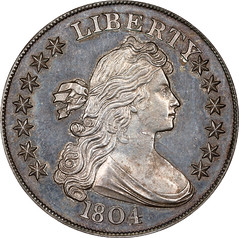 "Last week's edition was a very interesting one with multiple articles of interest and perhaps the most intriguing being the trail (or lack of) for the provenance of the 1804 Dollar in the James Stack collection that we all saw in Oklahoma City."
"Last week's edition was a very interesting one with multiple articles of interest and perhaps the most intriguing being the trail (or lack of) for the provenance of the 1804 Dollar in the James Stack collection that we all saw in Oklahoma City."
Len Augsburger writes:
"The piece was a bit speculative, but stirring the pot can be a good thing. Edgar Adams is as good a guess as any."
Bill Eckberg writes:
"Wholesale returns of conjecture out of such a trifling investment of fact. (Apologies to Mark Twain)"
The article's author Doug Ward writes:
"We'll see what appears, but unless Mr. Stack had a journal or ledger it's likely to be nothing but speculation... In such an event, there are very few other 'logical' choices. Unfortunately, numismatic history is littered with those more concerned in the end with their vanity, than with documenting their transgressions. Circumstantial evidence is all that remains. "
Yes, the idea is speculative, and hedged with words and phrases like "I would postulate" and "probably". As noted earlier, the auction catalog description for the James A. Stack 1804 Dollar has yet to be written and published, so stay tuned on the provenance of this piece. Clues that may have been overlooked before will be reviewed in the new light of this discovery and the inevitable speculation it spawns. As Len noted, Edgar Adams is a logical choice. But not the only one. The Fantastic 1804 Dollar has been the stuff of fantasy since its murky beginnings, so the latest discussions are only par for the course. And we'll look forward to more.
Here's a taste - Craig Sholley and John Dannreuther submitted the following. -Editor
We read Douglas Ward's article discussing the provenance of the 16 th known 1804 dollar and the Woodin fifty dollar ("half union") pattern debacle in the Aug. 31, 2025 issue of The E-Sylum and wish to point out several inaccuracies.
First, the historical record shows that it was Henry Linderman, not A. Loudon Snowden, who was behind the majority of the restriking prior to his death in 1879. Both mint records and historical auction records show that large-scale restriking for profit began at the mint in the mid-1850s and continued unabated through early 1864.
During that time Linderman was the "Director's Clerk." While that may sound like a minor clerical position, it was anything but. The mint's "Rules and Regulations," first written in 1795, reveal that the Director's Clerk was responsible for overseeing the day-to-day operations of the mint, including work assignments and ensuring the work was proceeding on schedule. He was literally the plant manager. He had all of the keys to the vaults and the combinations to the safes.
At this same time, A. Loudon Snowden was the "Registrar of Deposits," responsible for logging-in and recording all of the information about bullion deposits at the mint. He had nothing to do with coining or any other manufacturing operation. Linderman chose him as a partner-in-crime mainly because he was Mint Director James Ross Snowden's nephew. So, if Linderman was fired for his activities, the Director's nephew would also go, embarrassing James Ross and the entire family. Imagine explaining that one at the next family get-together.
We presented much of this information in several articles including "Gobrecht Dollar
Restrike and Cabinet Coins" in the June 2016 issue of The Numismatist and "The
Supposed Destruction of the Proof Half Cent Restrike Dies" in the January 2023 issue
of Pennywise. A summary is also available on the "DTS Die Stating Guide" website at
gobrechtdollars.com/emissionSeq.html.
As to the infamous half union pattern debacle, letters between Woodin and his lawyers discussing the matter came to light in 2004. The letters reveal that A. Loudon Snowden had sold the half union patterns to Woodin. When the government threatened legal action to recover them, Woodin returned the disputed pieces to A. Loudon, who summarily returned them to the mint, and repaid Woodin by giving him two trunks of patterns he had taken from the mint on his departure.
Dannreuther discussed these letters in his article, "William Woodin's Purchase of Two
Gold Half Unions" in the March 2013 issue of The Numismatist. Subsequently, Saul
Teichmann published the main letter detailing the origin of the patterns and their return
on US Patterns website under the listing for the half unions, Judd-1546, available at:
https://www.uspatterns.com/j1546p1719.html.
As to the 1804 dollars, new information has recently come to light which shows that Henry Linderman was responsible for both the Class II and Class III dollars. We will be presenting that information in an upcoming article.
To read the earlier E-Sylum articles, see:
NOTES FROM E-SYLUM READERS: AUGUST 24, 2025 : Can Coin Counterfeiters Fool the Experts?
(https://www.coinbooks.org/v28/esylum_v28n34a10.html)
ON THE PROVENANCE OF THE 16TH 1804 DOLLAR
(https://www.coinbooks.org/v28/esylum_v28n35a14.html)
NOTES FROM E-SYLUM READERS: SEPTEMBER 7, 2025
More on Scottish Banknotes
David Pickup writes:
 "Small point but I do not think that Scottish Banknotes are legal tender in England. The phase "legal tender" has a specific technical meaning but in the wider sense banks in England do not have to take them.
"Small point but I do not think that Scottish Banknotes are legal tender in England. The phase "legal tender" has a specific technical meaning but in the wider sense banks in England do not have to take them.
"One pound banknotes seemed to be used in Scotland much longer than in England when pound coins were introduced."
Sorry - I've seen many articles in the past about objections to these not being accepted, but had only assumed their legal status. Here's an earlier statement from the Scotsman: -Editor
"Apparently they are legal currency – approved by the UK parliament – but not legal tender. Not even in Scotland. In fact, no banknote whatsoever, even a Bank of England one, qualifies for the term "legal tender" north of the Border. But the Bank of Scotland has been issuing its own notes since it was founded 1695, with the Royal Bank of Scotland following suit in 1727 and then the Clydesdale a century later, in 1838.
"The vast majority of establishments in the rest of the UK are happy to take our cash."
To read the earlier E-Sylum articles, see:
ENGLISH MCDONALD'S REFUSES SCOTTISH BANKNOTES
(https://www.coinbooks.org/esylum_v19n39a40.html)
LOOSE CHANGE: AUGUST 31, 2025 : English Pub Chain Bans Scottish Banknotes
(https://www.coinbooks.org/v28/esylum_v28n35a23.html)
HIGGINS MUSEUM RECEIVED MAJOR DONATION
Great news! The Higgins Museum of National Bank Notes has received a major donation. -Editor
An anonymous Pennsylvania coin collector recently donated around $750,000 to the Higgins Museum of National Bank Notes. This marks one of the largest gifts in the Okoboji museum's 46-year history.
"Seven Lions," the anonymous donor, consigned 110 U.S. pattern coins to California-based auction house Stack's Bowers. The first 29 coins sold for $725,000 on July 27. Another $25,ooo came from the sale of 81 additional coins on Friday, Aug. 29.
Seven Lions plans to donate both auction proceeds, as well as hundreds of additional bank notes, to expand the museum's collection. The gift would add 700 national bank notes to the current 2,600-note display.
VOCABULARY TERM: ROCKER DIES
Here's another entry from Dick Johnson's Encyclopedia of Coin and Medal Terminology. -Editor
Rocker Dies. A pair of dies engraved on the curved interface surfaces, one convex and one concave. Unlike roller dies where the designs were engraved on cylinders and continuously rolled on a strip of metal (then blanked or cut out afterwards), an individual blank was impressed between a mated pair of rocker dies which were rocked back and forth under pressure until the design was struck up. This method required a special rocker press. It was intended to replace the screw press but did not.
Both of these coinage methods proved impractical: the rocker dies because of imperfect impressions and misshapen coins they created, and the roller die for the manual trimming necessary for individual coins after cutting out.
RICHARD DAVID KENNEY (1918-1957)
E-Sylum Feature Writer and American Numismatic Biographies author Pete Smith submitted this article on exonumia researcher and writer Richard D. Kenney. Thanks! -Editor
 During the ANA World's Fair of Money in Oklahoma City, I received a suggestion to write an
article about Richard D. Kenney. I appreciate such suggestions. This proved to be a challenge.
His family had a knack for keeping their names out of the papers.
During the ANA World's Fair of Money in Oklahoma City, I received a suggestion to write an
article about Richard D. Kenney. I appreciate such suggestions. This proved to be a challenge.
His family had a knack for keeping their names out of the papers.
I learned quickly that he had two names. Along the way, I came across a serious error in one of my usually reliable sources. Julia Casey helped me around that problem and found some great additional sources.
David Dombroff was born in Brooklyn on February 25, 1918. His father was a cap maker, Abraham Dombroff (1886-1923). His mother was Helen Heneze Sandhaus (1893-1983). They were married on June 3, 1917. Abraham died when David was only five years old. Helen remarried Herman Henry Gottehrur (1877-1944) on October 10, 1931.
NUMISMAGRAM MEDAL SELECTIONS: SEPTEMBER 7, 2025
Numismagram's Jeremy Bostwick sent along these five items from his most recent upload of new material to his site. For all of the new items, please visit https://www.numismagram.com/inventory. -Editor
103048 | GERMANY. Praise the Lord silver Medal. Issued circa 1750 (31mm, 9.26 g, 12h). By Johann Leonhard Oexlein in Nürnberg. DAS GESCHLECHT DER FROMMEN WIRD GESEGNET SEIN • PS • CXII (the descendants of the pious shall be blessed, –adapted from Psalm 112), draped figure of Charity seated facing, head lowered, holding open book and instructing three children around her; above, radiant manus Dei emptying flowers from overturned cornucopiae; Ö (for Oexlein) to lower right // DIE FORCHT DES HERRN IST DER WEISHEIT ANFANG • PS • CXI • (the fear of the Lord is the beginning of wisdom, –adapted from Psalm 111), scholar seated right at table, being admonished by veiled figure of the Church, holding long cross and pointing upward at radiant ???? (tetragrammaton) above; compass, globe, and measuring stick on ground below. Edge: Plain. GPH –; Plato –. PCGS MS-63. Extremely lustrous and flashy, with some elegant toning throughout as well. A scarce and impressive religious issue. $395.
Biblical themes were a very popular topic in German medallic art from the 17th-19th centuries, with parabolical medals–those that presented a Biblical lesson or recounted a passage from the Bible–a large portion of such medals. Figures from the Bible, baptisms, weddings, and the Ten Commandments are examples of the various themes that these medals would cover. One of the leading references for this area of medallic art is Kreß auction 115 from 1960, which presented the combined collections of Marie Luise Goppel and Dr. Plum-Holler, commonly referred to as Goppel-Plum-Holler, or simply GPH.
To read the complete item description, see:
103048 | GERMANY. Praise the Lord silver Medal.
(https://www.numismagram.com/product-page/103048)
WHITWELL HOARD OF BRITISH IRON AGE GOLD COINS
Noonan's will sell the Whitwell Hoard of five British Iron Age Gold staters as part of a sale on September 9, 2025. -Garrett
A small hoard of five British Iron Age Gold Coins (staters) that were discovered in Whitwell, near Worksop in Derbyshire by David McIntyre Haigh and his wife Judy Haigh, are estimated to fetch in the region of £5,000 at Noonans Mayfair in a sale of British, World and Ancient Coins & Historical Medals from Various Properties on Tuesday, September 9, 2025 at midday.
As Noonans Coin Specialist Alice Cullen explains: "This find is particularly special and unusual, being the largest hoard of Corieltauvian Staters found in Derbyshire. Only one other hoard has been found in the area to date, and it comprises two Staters, one of which is broken into fragments."
David started metal detecting back in 2010, with Judy joining him two years later, after selling their sign manufacturing business in North Derbyshire and taking an early retirement. They invested in two Deus Mk 1 Detectors and later the Deus11, an Equinox, several probes, and a Suzuki Vitara 4x4 Jeep to enable them to access ploughed fields and farmland. They chose to investigate parts of north Nottinghamshire and the Trent Valley due to its Roman history, never expecting to find an Iron Age hoard instead.
VICTOR-EMMANUEL III MEDALS OFFERED
Piguet Auctions of Geneva will be hosting an upcoming medals auction that will take place exclusively online from September 10 to 22 on piguet.com. -Garrett
 Victor-Emmanuel III of Italy (1869–1947) had a scholarly passion for the history of coins and medals. Throughout his life, he assembled one of the most extensive collections, regarded as a benchmark among connoisseurs. His son, King Umberto II (1904–1983), further enriched this prestigious collection, which was later preserved in part by his daughter, H.R.H. Princess Maria-Gabriella of Savoy.
Victor-Emmanuel III of Italy (1869–1947) had a scholarly passion for the history of coins and medals. Throughout his life, he assembled one of the most extensive collections, regarded as a benchmark among connoisseurs. His son, King Umberto II (1904–1983), further enriched this prestigious collection, which was later preserved in part by his daughter, H.R.H. Princess Maria-Gabriella of Savoy.
SOVEREIGN RARITIES AUCTION XIX
Sovereign Rarities will hold their Auction XIX on Tuesday September 23rd. Here are more selected lots. -Editor
Sovereign Rarities are proud to present their 19th Auction to be held at their London office on Tuesday 23rd September in conjunction with the Royal Mint. The online catalogue is now available to view at www.sovr.co.uk with images and estimates of every lot.
The sale commences with the magnificent Thorburn Collection of coins of 1887 mostly struck for the Golden Jubilee of Queen Victoria. This collection consists of over 200 coins arranged in 198 lots to begin the auction and covers everything numismatic from the Royal Mint medallions for the Jubilee and all the denominations in use for 1887 from the senior gold Five Pounds to the more lowly bronze Farthing as well as many patterns and proofs produced at the time for Adolph Weyl, J. Rochelle Thomas and Spink.
KUENKER AUCTION SALE 428
On 8 and 9 October 2025, auction 428 will take place. Among other highlights, it contains a special collection presenting more than 40 lots from Malta. The time span ranges from the High Middle Ages to the end of the Order state during the French Revolution. -Garrett
The coins and medals on offer feature not only portraits of the Grand Masters of the Sovereign Military Hospitaller Order of Saint John. We repeatedly encounter the Order of Knights' patron saint, St. John, or rather his head, which is usually depicted lying on a platter. Such depictions are also known from sculpture. Many Order churches had three-dimensional reminders of the beheading caused by Salome, some of which still exist today.


No. 1116: Sovereign Military Order of Malta. Juan de Omedes, 1536-1553. 4 tari, 1662, Birgu or Fort St. Angelo. Very rare. Very fine to extremely fine. Estimate: 7,500 euros


No. 1134. Sovereign Military Order of Malta. Hugues Loubens de Verdalle, 1582-1595. 4 tari, n.d., Valletta. Estimate: 4,000 euros
Of course, auction 428 also contains a rich selection of rarities from the field of world coins. We can only make mention of a few examples here.


No. 1111: Italy. Victor Emmanuele II, 1859-1861-1878. 5 lire, 1859, Bologna. Extremely rare. About FDC. Estimate: 17,500 euros


No. 1177: Poland. Stephen Báthory, 1576-1586. 1585 reichstaler, Baia Mare. Very rare. Extremely fine. Estimate: 10,000 euros


No. 1264: HRE. Tyrol. Ferdinand I, 1522-1558-1564. 1528 representative taler, Hall. Commemorating the hereditary homage paid by the Tyrolean diet. Extremely rare. About extremely fine. Estimate: 30,000 euros
There is also a rich selection of pieces from the German States. At this point, we can only mention a Bremen double taler by George of Brunswick-Wolfenbüttel from 1562. Bishop George was and remained Catholic during the conflicts surrounding the Reformation; however, he was unable to keep his bishoprics within the Catholic Church. Protestant historians have therefore tried to portray him as a reformist.
The fourth son of Henry I of Brunswick-Wolfenbüttel, George was destined for a career in the Church. Following his failure to take over the archbishopric of Riga in 1527, his family secured him the positions of provost in Hildesheim, cathedral provost in Cologne and in Bremen, and canonry in St. Gereon and Strasbourg. These offices did not only come with a generous income, but also with the theoretical possibility to advance to an even higher ecclesiastical office. His election as Bishop of Minden in 1554 came as something of a surprise, as his nephew Julius had actually been intended to fill this position. But the latter unexpectedly became heir apparent and recommended his uncle as his replacement to the Minden Cathedral Chapter. Four years later, George was also elected archbishop of Bremen and Verden, again succeeding a family member – his heavily indebted elder brother Christoph. Having been so successful in accumulating ecclesiastical offices, the ruler lists all these offices on his double taler: Archbishop of Bremen, confirmed [Bishop] of Minden and Verden, Duke of Brunswick. The last title obviously does not mean that George served as Duke of Brunswick. He was merely entitled to bear this title.


No. 1348: Brandenburg-Prussia. 1684 reichstaler, Magdeburg. Very rare. About FDC. Estimate: 35,000 euros


No. 1389: Brunswick and Lüneburg. Rudolph Augustus, 1666-1685. Löser of 4 reichstalers, 1679, Zellerfeld. Extremely rare. Extremely fine. Estimate: 50,000 euros


No. 1419: Bremen / Bishopric. George of Brunswick, 1558-1566. 1562 double taler, Bremen. Extremely rare. Extremely fine. Estimate: 75,000 euros


No. 1511: Mainz / Bishopric. Lothar Friedrich von Metternich-Burscheid, 1673-1675. 1674 broad double reichstaler, Mainz. Very rare. Extremely fine. Estimate: 30,000 euros


No. 1654: Prussia. Large silver coin tankard, created for the coronation of William I of Prussia on 18 October 1861. Extremely fine. Estimate: 25,000 euros
The term "numisnautics" has established itself over the past few decades. It was coined by the German numismatist Wolf Müller-Reichau when he and a few colleagues launched the magazine Flaschenpost (message in a bottle) as an information bulletin for the Numismatics Working Group in Germany. While ship depictions have long been a popular theme for collectors internationally, Flaschenpost drew the attention of many German collectors to questions about the history of nautical science that can be answered with the help of coins. Künker is pleased to offer the collection of a Berlin numisnautist, the first part of which is divided between auction catalogs 427 and 428. A second part will be auctioned in an upcoming eLive auction.


No. 1073: England. Elizabeth I, 1558-1603. 1588 silver medal, minted, unsigned, commemorating the destruction of the Spanish Armada. Very rare. About extremely fine. Estimate: 2,500 euros
As usual, the 2025 Fall Auction Sales will feature an interesting series of coins from the German Empire. Here are some of the highlights.


No. 1709: German Empire. Bavaria. 3 marks, 1918. Golden wedding jubilee of the royal Bavarian couple. Very rare. About FDC. Estimate: 30,000 euros


No. 2045: German Empire. Reuss / Older line. Henry XXII, 1859-1902. 20 marks, 1875. Very rare. Very fine to extremely fine / Extremely fine. Estimate: 25,000 euros


No. 2093: German New Guinea. 10 New Guinean marks, 1895. Very rare. Only 2,000 specimens minted. Extremely fine to FDC. Estimate: 50,000 euros
To order a catalog contact Künker, Nobbenburger Straße 4a, 49076 Osnabrück; phone: +49 541 / 962020; fax: +49 541 / 9620222; or via e-mail: service@kuenker.de. You can access the auction catalogs online at www.kuenker.de. If you want to submit your bid from your computer at home, please remember to register for this service in good time.
GADOURY OCTOBER 4, 2025 ROMAN AUREI SALE
Monaco's Gadoury Auctions will be selling a number of important Roman Aurei as part of their annual floor auction on October 4, 2025. Here are some selections. -Garrett
Aureus, 49-50, Lugdunum, AU 7.71 g. Obverse: TI. CLAVD. CAESAR. AVG. P. MR. TR. P. VIIII. IMP. XVI Laureate head of Claude on the right Reverse: PACI AVGVSTÆ Pax Nemesis (Victory) draped walking on the right, wings folded, bringing her right hand to her face and holding a caduceus in her left hand, preceded by a snake at her feet on the right Ref: Cal.369, C.60, RIC.33 Grading: NGC XF 5/5 2/5 edge marks Conservation: TTB-SUP
To read the complete item description, see:
Aureus, 49-50, Lugdunum, AU 7.71 g.
(https://www.biddr.com/auctions/gadoury/browse?a=6119&l=7521594)
1715 FLEET: PHILLIP II ROYAL DOCUMENT SEAL
The 1715 Fleet Society is a non-profit organization that is "dedicated to researching the history of the 1715 Fleet, its loss, rediscovery, and recovery." The 1715 fleet was part of the Spanish New World Treasure Fleets that funded Spain's activities as a world leader. However, by 1715, this position was in decline, which was exacerbated by this wreck. Here is their September Treasure of the Month article, republished with permission. -Garrett
Our featured Treasure of the Month for September is an item that was recovered earlier this year at the 1715 Fleet wreck site known as the "Cabin Wreck" by Captain Mike Perna (Member #217) and his crew operating the recovery vessel, Mighty Mo.
Made of lead and approximately 4" in diameter, this item appears to have the image of a seated figure with all the trappings of royalty. The reverse has no identifying features, save a vertical line through the center of the object.
THE LEWES POUND SHUTS DOWN
The Lewes Pound, a local currency used in Lewes, East Sussex, England, has shut down after the owners could not find anyone to take it over. Thanks to Jeff Starck for passing this along. -Garrett
The Lewes pound was a voucher that people could spend at more than 100 shops in the East Sussex town. Each Lewes pound was worth £1.
But in March, The Lewes Pound - the group which had run the scheme since 2008, announced it would be coming to an end after they were unable to find people to take it over.
Those with Lewes pounds had until Sunday to spend them, after which the notes expired.
Susan Murray, a director of The Lewes Pound, said: "It started as a way to support local independent businesses and we haven't really been able to measure that. We feel in the end it's probably only had a small impact.
MORE ON THE NEW SRI LANKA 2000 RUPEES NOTE
Dr. Kavan Ratnatunga's article on the new Sri Lanka banknote has been published in that country's Sunday Times. Here's an excerpt - see the complete article online. -Editor
On August 29 the Central Bank of Sri Lanka (CB) marked its 75th anniversary with the release of a commemorative Rs 2000 note. At first glance, the blue, green, and purple design is striking, and the inclusion of landmarks and motifs seems celebratory. Yet, a closer look reveals several unusual features, departures from tradition, and subtle signals worth reflecting on.
ABOUT THIS ISSUE: SEPTEMBER 7, 2025
Monday being a holiday here in the U.S. gave me a chance for an early start on this week's issue. I worked on Notes from E-Sylum Readers and forwarded some articles for Garrett to work on before heading across the street to our neighborhood picnic.
While working on the issue this afternoon I took time out to host a visitor - contributor Greg Bennick was in town on his way to Dulles Airport and he stopped in for a quick visit. We had a great time looking at books on errors and counterstamps, and he had with him a counterstamped colonial coin that came from the auction of my collection in 2006. We also looked at remainders from my American Journal of Numismatics hoard and works by J.S.G. Boggs. We had such fun in a short time that we forgot to take a photo to commemorate the occasion. Perhaps another time.
We've had discussions recently about artificial intelligence in numismatics. The big news this week is Anthropic's $1.5 billion copyright settlement over its use of pirated books in its training data. The settlements amount to about $3,000 per book. That's a victory for the authors in that suit, but the interesting part will be what happens next. AI companies have shown some willingness to pay certain publishers for use of their copyrighted products, but the bar is pretty high. One development to watch could be Cloudflare's gatekeeper tools that enable a for websites and AI companies to negotiate licensing and payment agreements. Here are some related articles.
Anthropic Agrees to Pay Authors at Least $1.5 Billion in AI Copyright Settlement
(https://www.wired.com/story/anthropic-settlement-lawsuit-copyright/)
Cloudflare is arming content creators with free weapons in the battle against AI bot crawlers
(https://fortune.com/2024/09/23/ai-bot-crawlers-cloudflare-content-creators/)
Finally, here are some interesting non-numismatic history articles I came across this week. The first two are from Jack El-Hai's Damn History newsletter.
The Early Modern Camera Obscura
(https://publicdomainreview.org/essay/the-early-modern-camera-obscura/)
Everyone Had A Feather Bed
(https://birdhistory.substack.com/p/everyone-had-a-feather-bed-da4)
And a cocktail party question: can you name the only two countries in the world with an X in their name? -Editor

